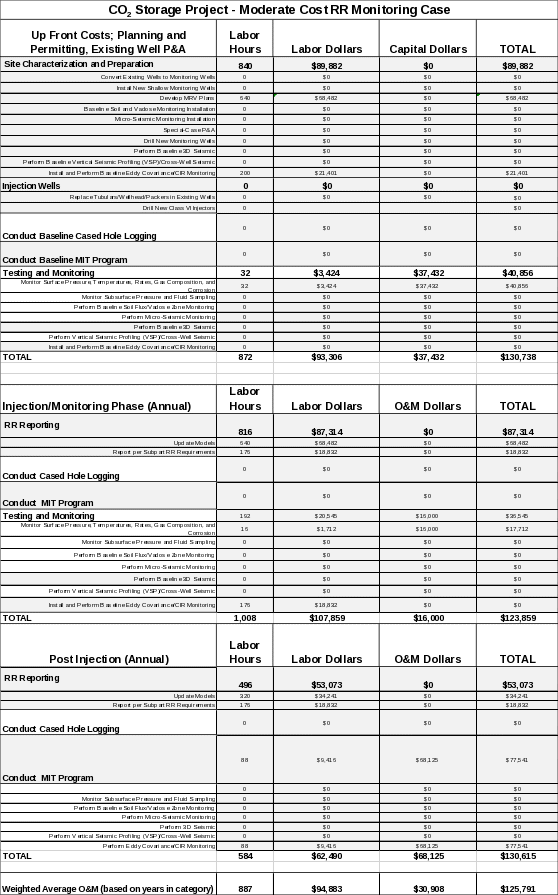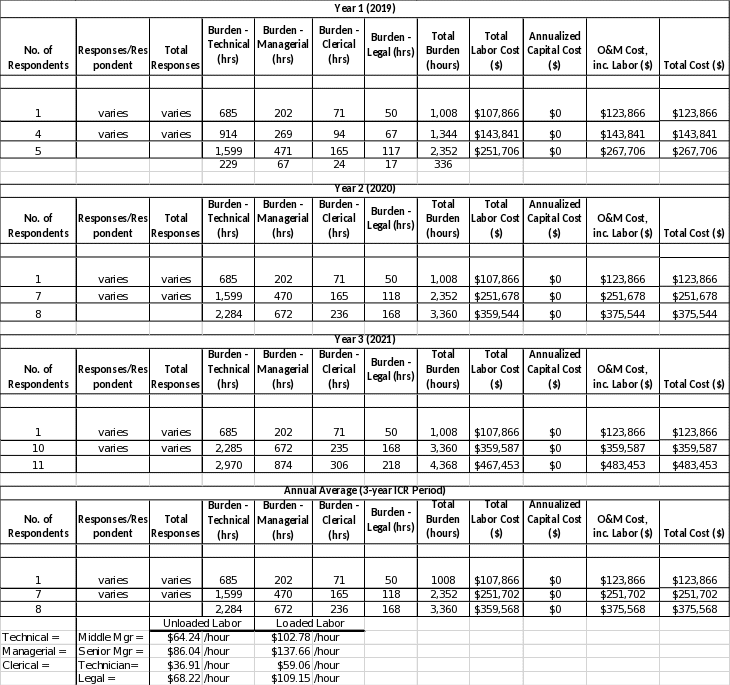Appendix G
Appendix_G_SUBPART_RR.docx
Greenhouse Gas Reporting Program (Renewal)
Appendix G
OMB: 2060-0629
Appendix G:
Burden and Cost Estimate for Geologic Sequestration of Carbon Dioxide (Subpart RR)
June 2019
The objective of this appendix is to summarize updated burden and cost estimates for subpart RR of the Greenhouse Gas Reporting Program (GHGRP). More detail on the methodology, assumptions, and estimated costs, including costs for potential alternative cost scenarios, are presented in the docket.1
Subpart RR monitoring and reporting costs are estimated based on two types of facilities:
Projects permitted under Class II of EPA’s Underground Injection Control (UIC) program (primarily for carbon dioxide enhanced oil recovery (“CO2-EOR”) wells).
Projects permitted under Class VI of EPA’s UIC Program (assumed to be injecting into deep saline formations for purposes of the analysis).
The geologic and project characteristics of the “representative” facility for both the CO2-EOR and the deep saline aquifer case are based on a typical CO2-EOR project in the Permian Basin of West Texas, where the majority of ongoing CO2-EOR operations in the U.S. exist. This “representative” facility is comparable to that used in previous EPA subpart RR analyses.
This update takes into consideration activities and events occurring since the last estimate in 2016. Specifically, monitoring, reporting, and verification (MRV) plans for CO2-EOR and deep saline CO2 storage projects have been approved by EPA.2 Cost estimates have been updated based on the activities reflected in the approved plans.
CO2-EOR projects that have submitted MRV plans to EPA operate with rigorous monitoring already in place, to ensure efficient and economically viable operation. Based on the approved MRV plans for Class II/CO2-EOR operations, the incremental costs are assumed to be associated with the development of an MRV plan and reporting and recordkeeping costs to meet subpart RR requirements (e.g., submission of annual reports). It is assumed that models are updated every other year during the injection phase, and every four years during post-injection. This results in incremental annual costs of $35,960 during the injection phase. No reporters are assumed to be in the post-injection phase over the time frame of these estimates.
Table 1 summarizes the MRV activities assumed for a MRV plan for a deep saline formation project, which are assumed to be incremental to activities that may be associated with a Class VI permit. Table 2 summarizes the incremental unit burden and cost estimates under subpart RR for a deep saline formation project based on these assumed activities.
In addition, in February 2018, the Bipartisan Budget Act of 2018 extended and enhanced the federal Internal Revenue Code (IRC), Section 45Q tax credits.3 It is anticipated that the tax credit enhancements will stimulate additional geologic sequestration projects.
For purposes of this analysis, it is assumed that one deep saline formation CO2 storage project would report under subpart RR in year 1 (2019), year 2 (2020), and year 3 (2021). It is also assumed that four CO2-EOR projects would report under subpart RR in year 1, seven in year 2, and ten in year 3.
Taking into consideration the unit cost and burden estimates for CO2-EOR and deep saline formation facilities, and the estimated number of impacted facilities stated above, estimates for the incremental burden and associated costs for subpart RR are presented in Table 3.
Table 1. Deep Saline Formation: Subpart RR Baseline Scenario
-
MRV Activity
Deep Saline Formation
Operation
Develop MRV plans and update models
YES
Report per subpart RR requirements
YES
Convert some existing wells to monitoring wells
IN PLACE
Install shallow monitoring wells
IN PLACE
Perform soil flux/vadose zone monitoring
IN PLACE
Perform micro-seismic monitoring
IN PLACE
Special-case P&As
IN PLACE
Drill new deep monitoring wells
IN PLACE
Perform 3D seismic
IN PLACE
Perform eddy covariance/CIR monitoring
YES
Conduct cased hole logging
IN PLACE
Conduct MIT program
IN PLACE
Monitor surface pressure, temperatures, rates, gas composition, and corrosion
IN PLACE
Monitor subsurface pressure and fluid sampling
IN PLACE
YES = will be in MRV Plan
IN PLACE = already in place
Table 2. Baseline Unit Burden and Cost Estimates for Deep Saline Formation Projects: Subpart RR Baseline Scenario

Table 3. Total Burden and Cost Estimates for Subpart RR

1 Analysis of the Costs Associated with Subpart RR (Geologic Sequestration of Carbon Dioxide) Reporting under the EPA Greenhouse Gas Reporting Program, paper prepared by Advanced Resources International, Inc., May 2018.
| File Type | application/vnd.openxmlformats-officedocument.wordprocessingml.document |
| Author | Mike Godec |
| File Modified | 0000-00-00 |
| File Created | 2021-01-15 |
© 2025 OMB.report | Privacy Policy